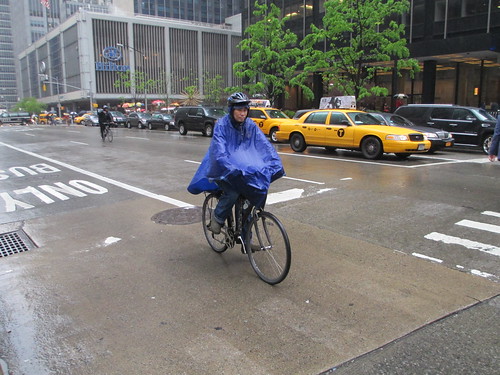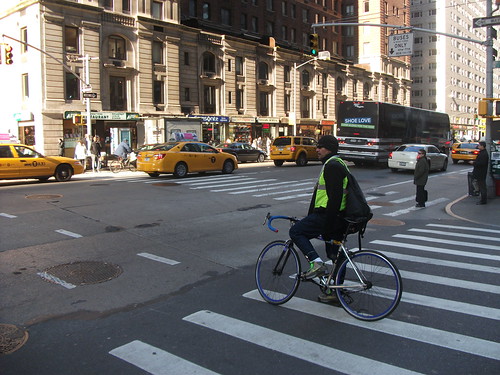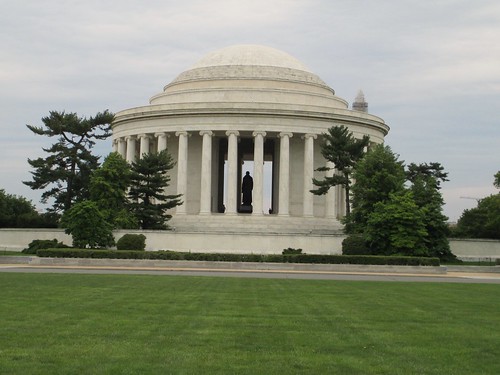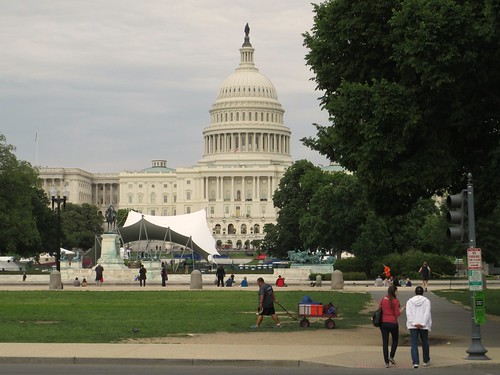It was one evening a few months ago that I encountered the
cyclist with the battered road bike and back pack. I was shuttling my
bike-cleaning equipment up bit by bit from the yard of our building when I
found him sharing the elevator with me. I launched into the kind of small talk
I’m practised at using on cycling neighbours. “Do you ride far?” I asked.
All delivery cyclists, meanwhile, can deploy the devastating argument that occurred to me when, one Saturday afternoon, my family and I were passed far too close in Brooklyn Heights by a poorly-driven car bearing the logo of a nearby pizza restaurant. The alternative to negligently, lawlessly handled delivery bicycles probably isn't polite, legal delivery bikes but negligently, lawlessly-driven motor vehicles. It may even - who knows? - have been that the restaurant turned to cars to avoid New York's new, strict delivery biker regulations.
Sure, it's annoying that the delivery guy from the local Mexican comes the wrong way down the bike lane at you. Sure, the pizza joint guy shouldn't have buzzed you in the crosswalk as you crossed. But thank goodness they didn't do it with a car.
It was only after I left the elevator that I realised he
wasn’t a neighbour. He had come from a Mexican restaurant in Red Hook, he said.
They had a huge delivery area - but used specially-designed insulated back
packs to keep the food warm. I had, it dawned on me, just for the first time talked to a New York
food-delivery cyclist about subjects beyond which bag held the plum sauces or
whether I could pay by credit card.
 |
| Delivery cyclist, rain, Sixth Avenue. Sure, you might sometimes choose to ride in such weather. But would you want to ride in it or be fired? |
It’s probably revealing that I got into the discussion having
mistaken the delivery biker for a neighbour. I regularly engage other commuter
cyclists in chat at traffic lights. I remark on their bikes (especially if
they’re fellow Surly owners) the weather (alternately superb or not a great
advert for cycle commuting) or the behaviour of New York City drivers (on whom I don’t
generally heap praise). I don’t on the other hand tend to strike up
conversation if I find myself next to a man with bags of lo mein dangling from
his handlebars or carrying a basketful of tacos. I don’t seem to regard these
cyclists – or, to some extent, working cyclists generally – as part of my
cycling tribe.
City authorities worldwide tend to be still less warm-hearted.
The couriers that played a vital role in ferrying documents around the City of London were a still
bigger target for the City Police’s ire than cyclists in general. New York City
Council has a history of regarding the working cyclist – the person who delivers
the documents and food that keep the city’s financial services and media
industries functioning and fuelled – as a problem on a par with the city’s rat
or bedbug problem. It probably can’t be stamped out but needs controlling by
whatever means possible.
New York's City Council also seems to listen to working cyclists – who work long hours in
far-from-safe conditions for minimal wages – about as attentively as it listens to the vermin. I’ve never seen any sign that
the city councillors most vocal about the delivery bikers’ perceived
shortcomings are pressing their employers significantly to improve their conditions. Nor have
I heard of any taking any interest in the welfare of the bikers who deliver
their own pizza or noodle boxes.
Yet working cyclists are the only cyclists in most big
cities whose numbers and cycling conditions non-cyclists can directly
influence. Call out for lunch and you’re pitching some poor Vietnamese or
Mexican delivery cyclist onto the streets, regardless of whether or not you
think they’re safe. Tell your secretary in Mayfair to get a document to Canary Wharf
 |
| Snow in March: Thoughtful New Yorkers preferred letting cyclists riding in this to messing up their shoes |
The working cyclist’s plight came home to me particularly
starkly in March, when a surprise late snowfall blew in, turning midtown Manhattan into a
miserable, low-visibility mess of slush and dampness. It was one of a handful
of days since I arrived in New York
that I decided cycling wasn’t the best way to get to work. Other commuter
cyclists, I knew, were forsaking their normal means of transport for the
comforts – if that isn’t too strong a word – of the subway. But, as I walked,
head down, towards my lunchtime kebab cart, I noticed there seemed to be more
delivery bikers than normal out there, not fewer. In the skyscrapers around me,
office workers were looking out their windows, shuddering at the idea of subjecting
their fancy shoes to the soggy sidewalks and phoning for some poor immigrant to
bring them lunch on his bike instead.
But, while the delivery cyclist bringing food or documents
to one’s own desk is performing a vital service, those serving other people’s
needs seem to be a confounded nuisance. Bike couriers tend to be firmly among the "cyclists who get cycling a bad name" for the kind of person who sucks his or her teeth over the behaviour of London cyclists. In New York, it's axiomatic to complain that food delivery bikers all
constantly ride the wrong way down one-way streets, terrorise pedestrians at
red lights and ride on the sidewalks. New York City Council’s transport committee, putting to one side
the challenges of tackling the city's 250 to 300 annual deaths in motor vehicle crashes, has passed a bill in the past
year demanding, among other things, that delivery cyclists display a
personal identification number and the identification of their business. There’s
also been an attempt to crack down harder on e-assist bikes – a fairly
transparent effort to get at a means of transport popular with delivery
cyclists.
The very name of one piece of city council legislation raises questions about how big a problem delivery bikers really are. The law is named after Stuart Gruskin, who died after
being hit by a delivery cyclist going the wrong way on a street in March 2009. Tragic
and painful though Mr Gruskin’s loss undoubtedly must remain for his family, no-one
has died after colliding with a cyclist in New York City in the four years since.
I certainly wouldn't defend all working cyclists' standards. I had a nasty near-miss in Cobble Hill late one night with a delivery cyclist who ran a red light into my path. I’m frequently unimpressed with the way some riders squeeze past me in the evening on theW55 street bike lane. The only other cyclist I’ve ever knocked off was a courier who made a foolhardy, last-minute swing in front of me at a junction in London just as the lights turned green.
I do, however, recognise that even I find New York's grid system frustrating as a cyclist - and I have the luxury of never riding in city traffic more than a few times a day and not losing any pay if I'm late. Would I follow all the street direction rules if the restaurant where I worked were on a one-way street and it would add five minutes to every trip to go the right way round the block to reach it? Would I wait at the lights every time if I knew that doing so would leave me scores of times a day jostling with several streams of fast-moving, inconsiderate taxis? Would I expect my bosses to back me if I explained that my productivity was lower than other delivery bikers’ because unlike them I assiduously followed the rules?
I certainly wouldn't defend all working cyclists' standards. I had a nasty near-miss in Cobble Hill late one night with a delivery cyclist who ran a red light into my path. I’m frequently unimpressed with the way some riders squeeze past me in the evening on the
I do, however, recognise that even I find New York's grid system frustrating as a cyclist - and I have the luxury of never riding in city traffic more than a few times a day and not losing any pay if I'm late. Would I follow all the street direction rules if the restaurant where I worked were on a one-way street and it would add five minutes to every trip to go the right way round the block to reach it? Would I wait at the lights every time if I knew that doing so would leave me scores of times a day jostling with several streams of fast-moving, inconsiderate taxis? Would I expect my bosses to back me if I explained that my productivity was lower than other delivery bikers’ because unlike them I assiduously followed the rules?
It would be easy to construct an alternative narrative about working cyclists. They are after all ready every day to take significant risks in traffic, get food and documents to people faster than a motor vehicle could and create virtually no carbon emissions or pollution in doing so. I admired how the delivery bikers in March's snow negotiated piles of slush that must be making conditions under their wheels treacherous. I tend to believe that a great deal of the anger directed at delivery cyclists reflects general prejudices against cyclists. In the case of food delivery bikers, there's the added element of the racism often directed at poor immigrants in unpopular, poorly-paid jobs.
There should certainly be some scope for cycling advocacy groups to stand alongside working cyclists on some issues. It's hard to imagine that a movement in the highly-fragmented, ultra-competitive New York catering industry will look quite the same but in New York in 1987 couriers and commuter cyclists stood together against efforts by Ed Koch, then mayor of New York , to ban day-time cycling in
midtown Manhattan. The measure was intended mainly to make bike couriers' lives more difficult. The successful protest movement encouraged the development of some of the
cycling advocacy groups still at work today in New York .
All delivery cyclists, meanwhile, can deploy the devastating argument that occurred to me when, one Saturday afternoon, my family and I were passed far too close in Brooklyn Heights by a poorly-driven car bearing the logo of a nearby pizza restaurant. The alternative to negligently, lawlessly handled delivery bicycles probably isn't polite, legal delivery bikes but negligently, lawlessly-driven motor vehicles. It may even - who knows? - have been that the restaurant turned to cars to avoid New York's new, strict delivery biker regulations.
Sure, it's annoying that the delivery guy from the local Mexican comes the wrong way down the bike lane at you. Sure, the pizza joint guy shouldn't have buzzed you in the crosswalk as you crossed. But thank goodness they didn't do it with a car.






